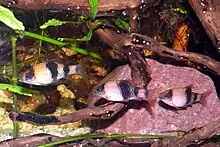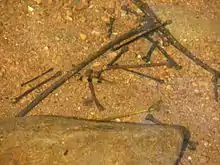| Melon barb | |
|---|---|
 | |
| Scientific classification | |
| Domain: | Eukaryota |
| Kingdom: | Animalia |
| Phylum: | Chordata |
| Class: | Actinopterygii |
| Order: | Cypriniformes |
| Family: | Cyprinidae |
| Subfamily: | Barbinae |
| Genus: | Haludaria |
| Species: | H. fasciata |
| Binomial name | |
| Haludaria fasciata (Jerdon, 1849) | |
| Synonyms | |
| |
The melon barb (Haludaria fasciata) is a common species of cyprinid fish that is endemic to rivers in Goa, Karnataka, Kerala and Tamil Nadu in the Western Ghats of South India.[1] They live in a tropical climate in water that typically has a pH of 6.0—6.5, a water hardness of around 5 dGH, and a temperature range of 22–26 °C (72–79 °F).[2] This species can also be found in the aquarium trade.[2]

Melon barb – Puntius fasciatus – Vazhakka varayan
The melon barb is an open water, substrate egg-scatterer, and adults do not guard the eggs. It grows to a length of 6 centimetres (2.4 in).[1]
See also
References
Wikimedia Commons has media related to Puntius fasciatus.
- 1 2 3 Abraham, R. 2011. Haludaria fasciata. In: IUCN 2012. IUCN Red List of Threatened Species. Version 2012.2. <www.iucnredlist.org>. Retrieved 3 May 2013.
- 1 2 Froese, Rainer; Pauly, Daniel (eds.) (2013). "Haludaria fasciata" in FishBase. October 2013 version.
This article is issued from Wikipedia. The text is licensed under Creative Commons - Attribution - Sharealike. Additional terms may apply for the media files.
